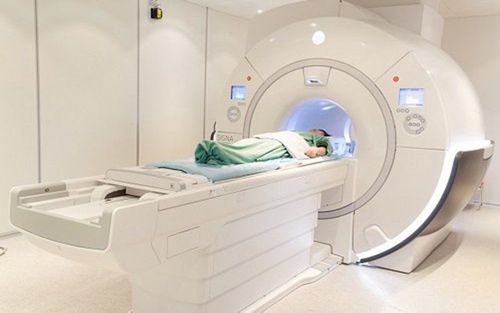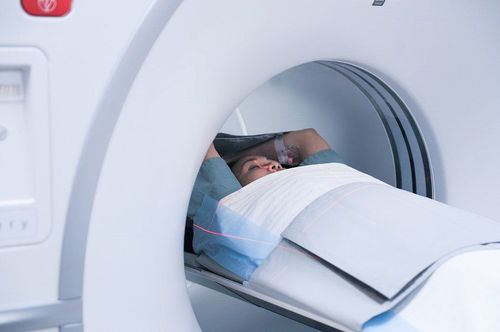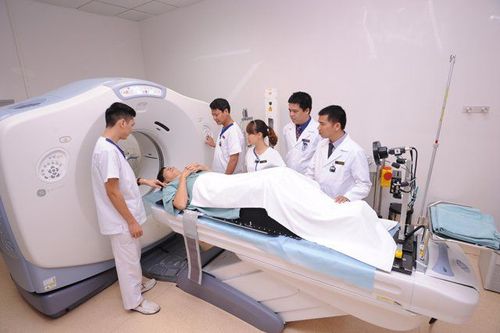This is an automatically translated article.
The article was professionally consulted by Specialist Doctor I Nguyen Truong Duc - Radiologist - Department of Diagnostic Imaging and Nuclear Medicine - Vinmec Times City International General Hospital. Dr. Duc has more than 17 years of experience in diagnostic imaging.Magnetic resonance imaging is a modern diagnostic imaging method, which is a tomography technique that uses magnetic fields and radio waves to perform. Magnetic resonance imaging can detect neurological, musculoskeletal, cancer, cardiovascular, obstetric and many other diseases.
1. What is magnetic resonance imaging?
Magnetic resonance imaging, also known as MRI, is a diagnostic method by capturing images of organs in the body. This is a tomography technique that uses magnetic fields and radio waves. When the hydrogen atoms in the human body are under the influence of magnetic fields and radio waves, they absorb and release RF energy. This release is received, processed, and converted by the machine into an image.Magnetic resonance imaging with high contrast, sharp and clear, produces detailed images, good anatomy and 3D reconstruction ability to bring effective diagnosis to doctors for disease pathology core. New techniques in magnetic resonance imaging allow not only visual assessment but also functional and chemical evaluation. In addition, magnetic resonance imaging does not use radiation, so this method is very safe and highly appreciated by professional doctors in the indication of imaging and disease diagnosis.
Some of the advantages of magnetic resonance imaging include:
More indications for investigation than other imaging techniques No use of X-rays or ion radiation High-resolution images, with Sharp 3D reconstruction Good assessment of cerebral perfusion status or the nature of lesions in brain tumors. Good assessment of the condition of very small organs inside the body such as nerves, blood vessels. However, it should be noted that magnetic resonance imaging is not applicable to patients with metal implants inside the body. Because the machine's high magnetic field can damage those devices. Therefore, to ensure safety, patients must inform medical staff about their medical history. Before the procedure, the patient will need to follow the instructions of the medical staff such as removing jewelry, mobile phones,...
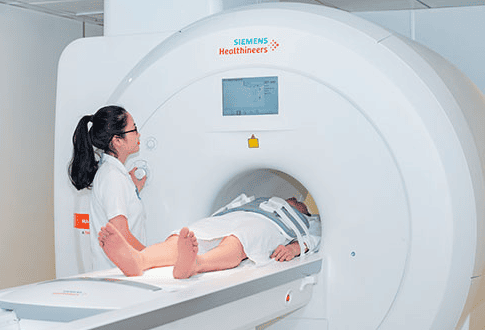
Chụp cộng hưởng từ là phương pháp chẩn đoán hiện đại
2. What diseases can magnetic resonance imaging detect?
Magnetic resonance imaging can be used in almost any diagnosis of the body's organs. However, this method has special value in taking detailed images of the brain, musculoskeletal, cardiovascular and some cancers,...2.1 Detecting brain diseases
Some pathological conditions of the brain can be detected by magnetic resonance imaging such as: cysts, brain tumors, hemorrhage, edema or abnormal structures in the brain,... In addition, Magnetic resonance imaging may be done to identify arteriovenous fistulas and brain damage caused by trauma or stroke. New techniques such as perfusion magnetic resonance, magnetic resonance spectroscopy, magnetic resonance axonal assessment help in-depth diagnosis of neurological diseases.Magnetic resonance imaging method produces clear images of brain parenchyma, thereby helping to detect chronic diseases of the nervous system, the part that cannot be clearly seen on X-ray, CT- scan or ultrasound. Magnetic resonance imaging will help diagnose accurately, with less errors in pituitary and brain stem diseases.
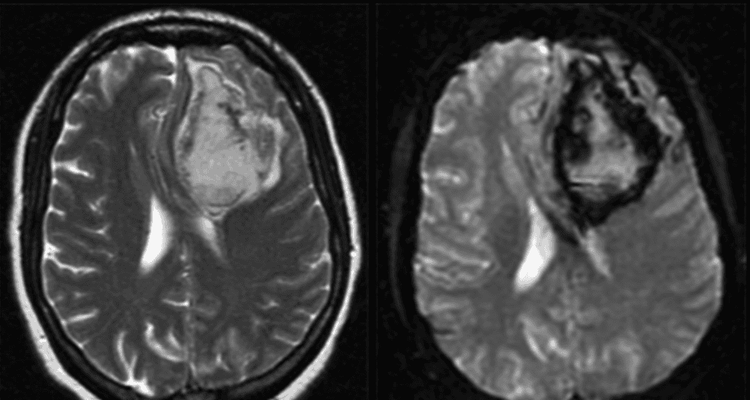
Hình ảnh MRI xuất huyết não
2.2 Detecting musculoskeletal diseases
Magnetic resonance imaging is the best musculoskeletal imaging method to evaluate the entire structure of this organ region. From there, signs related to damage to bones, muscles, tendons, cartilage, ligaments, ... will be detected quickly. Currently, musculoskeletal magnetic resonance imaging is often indicated in the diagnosis and treatment of the following diseases:Osteoarthritis and soft tissues such as muscles, tendons, ligaments,... Osteoarthritis, fracture cruciate ligaments, joint injuries such as meniscus tears, fractures,... Infections Osteomyelitis Tumors and bone metastases Pain swelling and edema in the joints of the extremities.
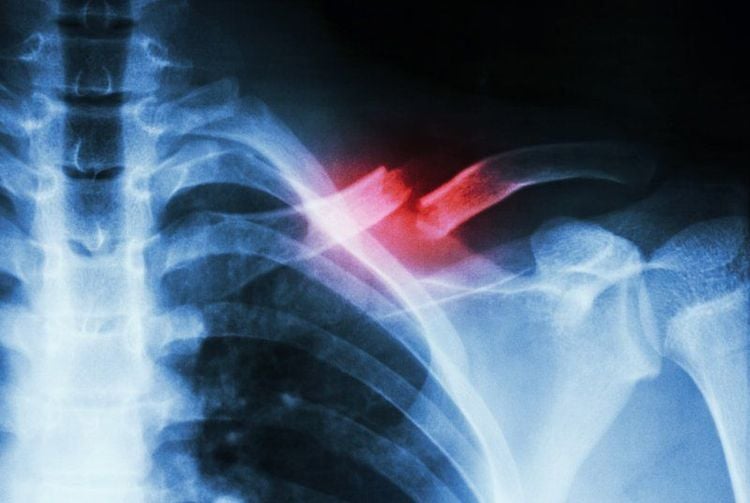
Các tổn thương ở xương khớp có thể được chẩn đoán khi chụp MRI
2.3 Detection of cancers
Magnetic resonance imaging of the abdomen - pelvis to detect liver and biliary tract diseases such as liver tumors, cholangiocarcinomas, gallstones, etc. .. Pathologies of pancreas, spleen, kidney, adrenal gland. Diseases of the pelvic region such as colorectal cancer, prostate cancer, uterine tumor, vaginal prolapse, ovarian tumors. Especially accurately assess the stage of endometrial cancer, cervical cancer, prostate cancer,... Moreover, mammogram will help diagnose early and accurately the lesions. lesions in the mammary gland such as benign, malignant tumors and infections in the breast,...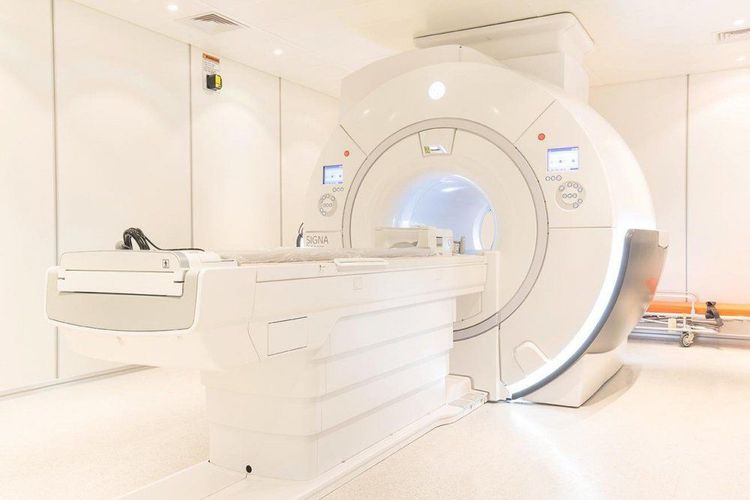
Hệ thống máy chụp cộng hưởng từ MRI 3.0 Tesla hiện đại tại Bệnh viện Vinmec Hải Phòng
2.4. Cardiovascular magnetic resonance imaging application
Helps to evaluate the anatomy and function of the heart chambers, heart valves, myocardium. Assess myocardial perfusion. In vascular disease, magnetic resonance imaging helps to shape arterial systems such as cerebral vessels, carotid vessels, limb vessels, renal vessels...2.5. Several specific pulse sequences help to quantify iron deposition in liver and heart tissue, and to quantify fatty deposits in the liver.
Magnetic resonance imaging has high organizational resolution, captures many planes, and has many examination pulse sequences. Thereby, it can easily detect lesions at the cellular level, and evaluate changes in organizational function. Therefore, this diagnostic method is considered as one of the best options for early detection of cancer diseases.
In addition, the use of magnetic resonance imaging technology also helps to detect and warn as well as distinguish malignant or benign lesions, serious or common metastases of cancer cells. Thanks to that, doctors will develop the most accurate treatment regimen for the patient, helping to minimize the dangers caused by the disease.
In summary, magnetic resonance imaging is one of the imaging methods by capturing images of organs in the body, is a tomography technique using magnetic fields and radio waves. This method helps diagnose neurological, musculoskeletal, cardiovascular, and cancer diseases,... Moreover, magnetic resonance imaging does not use radiation, so this method is very It is safe and highly appreciated by professional doctors in the indications of imaging and disease diagnosis.
Currently, Vinmec International General Hospital has put into use a 3.0 Tesla magnetic resonance imaging machine with Silent technology. Magnetic resonance imaging machine 3.0 Tesla with Silent technology of GE Healthcare (USA).
Silent technology is especially beneficial for patients who are children, the elderly, weak health patients and patients undergoing surgery. Limiting noise, creating comfort and reducing stress for customers during the shooting process, helping to capture better quality images and shorten the shooting time. Magnetic resonance imaging technology is the technology applied in the most popular and safest imaging method today because of its accuracy, non-invasiveness and non-X-ray use. With a modern MRI scanner system Under the implementation of a team of experienced medical doctors, they will produce accurate imaging results, making a significant contribution to the diagnosis and staging of the disease.
Please dial HOTLINE for more information or register for an appointment HERE. Download MyVinmec app to make appointments faster and to manage your bookings easily.






